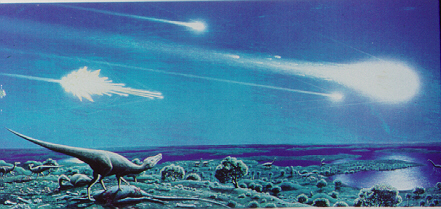
What Killed The Dinosaurs?
EXTINCTION THEORIESTwo main camps exist in paleontology today, each having a different view of what killed the dinosaurs and other organisms at the K-T boundary. Controversy has surrounded the topic since 1980; it has become difficult for the public (and the scientific world at large) to understand the issue due to the tangled assemblage of data which seems to point in many different directions. Luckily, the controversy has not harmed the study of mass extinction causation, but rather has made it a dynamic and interesting area. Every groundbreaking new hypothesis makes new headlines in the media, and excites researchers to delve further into the mystery.
The major sides of the schism can be broken down (greatly simplifying the issue, but making it more accessible) into "intrinsic gradualists" and "extrinsic catastrophists." We'll describe each generalized group in turn, and then try to synthesize the available information so you can form your own opinion. But first, let's outline what scientists generally agree that we know about the K-T boundary.
The common ground
- There was global climatic change; the environment changed from a warm, mild one in the Mesozoic to a cooler, more varied one in the Cenozoic. The cause of this climate change, and the speed at which it proceeded, are the major concerns of both schools of thought.
As well as a permanent global climatic change, there is evidence that there were less lasting changes at the end of the Cretaceous period. These changes may have been the result of a massive terrestrial disturbance, which threw up soot into the air, causing short term acid rain, emission of poisonous gases, and cooling (similar to a nuclear winter). Long term consequences would have been a global greenhouse effect (warming and reduced sunlight).
As discussed before, many organisms; both marine and terrestrial, vertebrate and invertebrate; went extinct. The reason for this extinction was probably this climate change.
At or near the K-T boundary in several places around the globe, we have a thin layer of clay with an unusually high iridium (a rare metal similar to platinum) content. This may be evidence for the dust cloud in #2 above.
The "intrinsic gradualists"
Those scientists falling into this category believe that the ultimate cause of the K-T extinction was intrinsic; meaning of an Earthly nature; and gradual, taking some time to occur (several million years). Two main hypotheses exist today:
- Volcanism: We are quite certain that the end of the Cretaceous period that there was increased volcanic activity. Over a period of several million years, this increased volcanism could have created enough dust and soot to block out sunlight; producing the climatic change. In India during the Late Cretaceous, huge volcanic eruptions were spewing forth floods of lava which can be seen today at the K-T boundary (these ruptures in the Earth's surface are called the Deccan traps). The chemical composition of the lava rocks in India shows that they originated in the Earth's mantle, which is also relatively rich in iridium. This richness would explain the iridium layer.
Plate Tectonics: Major changes in the organization of the continental plates (continental drift) were occurring at the K-T boundary. The oceans (especially the Interior Seaway in North America) were experiencing a regression; they were receding from the land. A less mild climate would have been the result, and this would have taken a long time. Large scale tectonic events did occur in the Mesozoic several times, and no extinction events have been conclusively associated with them yet.
Note that these two above hypotheses are inextricably tied together; volcanism cannot occur without the action of plate tectonics, and vice versa. If the extinction was intrinsic and gradual, both processes probably played a role. Also note that the basic theory here is an elaboration of the 'dinosaurs faded away' hypothesis from the invalid hypotheses section; it adds a factor of causation that is quite convincing.
The "extrinsic catastrophists"
This side of the controversy holds that the ultimate cause of the K-T extinction was extrinsic, meaning of an extraterrestrial nature, and catastrophic, meaning fairly sudden and punctuated. The main hypothesis was proposed in 1980 by (among others) Luis and Walter Alvarez of the University of California at Berkeley.
The Alvarez Hypothesis: The original hypothesis is the basis for several subsequent variations on the theme that a large extraterrestrial object collided with the Earth, its impact throwing up enough dust to cause the climatic change. The iridium layer is what prompted the Alvarez team to blame an asteroid impact for the extinction — asteroids and similar extraterrestrial bodies are higher in iridium content than the Earth's crust, so they figured that the iridium layer must be composed of the dust from the vaporized meteor. No crater was found, but it was assumed that one existed that was about 65 million years old and 100 kilometers (about 65 miles) in diameter.
Later research found a likely candidate for the crater at Chicxulub, on the Yucatan Peninsula of Mexico. Other evidence was also reported: the presence of shocked quartz in the rocks of the K-T boundary (indicating the passage of a shock wave so powerful that it actually rearranged the crystal structure of quartz grains), glassy spheres that looked like impact ejecta (molten rock that solidified into droplets when cooled), and a soot layer was found in many areas (evidence for widespread forest fires). The likelihood that massive hurricanes and firestorms would have raged across the Earth was also hypothesized, adding to the destructive power of the catastrophe.
To reconcile the hypothesis with gradual data, it was suggested that rather than one impact, several impacts (of comets or meteors) could have occurred over a period of many years. Some evidence supported this — a hint of periodicity of mass extinctions in the fossil record was reported; mass extinctions seemed to occur roughly every 26 million years. Astronomers theorized that the Oort cloud of comets could cross the path of our solar system every 26 million years, and would possibly rain comets on our planet for a few million years. The existence of a tenth, as-yet unseen planet — or Nemesis, the twin star to our sun — both with large orbits were also contemplated. To date, no reliable evidence for periodicity or Nemesis-type celestial bodies has been found, but this does not render the hypothesis obsolete; it is accepted that any large extraterrestrial body impacting the Earth's surface could and would produce climatic changes similar to those thought to have occurred around the K-T boundary.

All of this work was not without its detractors, of course; we'll discuss that in the final section.
Conclusions?
There has been no settlement to the issue so far, and no clear one is foreseeable. Both sides claim to hold the majority of proponents in science; it seems that (greatly over-generalizing) many paleontologists lean towards the intrinsic side, while many astronomers and physicists favor the extrinsic side, and geologists are probably evenly split between the two.
All of the evidence cited for the extrinsic catastrophist side is claimed as evidence by the intrinsic gradualists for their side or against the opposite side — volcanoes could create the iridium layer, shocked quartz, soot, and impact ejecta; the makeup of the iridium layer is not uniform in all areas, so it could be meaningless; and so on.
The main problem with both hypotheses is the issue of the selectivity of the mass extinction; as you saw before in the background section, some organisms were wiped out, while others were unaffected. Can climate change really explain the differential selectivity of the K-T event? Our lack of understanding of the physiology of dinosaurs makes the issue more complex; if they were endothermic, why did they not survive like birds and mammals? If they were ectothermic, why did small dinosaurs not survive like small reptiles?
Also, many studies have focused on the extinction of dinosaurs alone, and have forgotten about the more substantial marine ecosystem collapse. The fossil record suggests that some marine reptiles died out several million years prior to the K-T boundary.
Other major problems with the issue are that it is not easy to prove (test) causation (as noted before), and that most of the ages of the rocks that different evidence comes from are questionable. It is not certain whether there is a gradual decline in the global fossil record, or if there was a sudden catastrophe; some studies in some areas show evidence pointing to different answers.
Ultimately, we just don't know yet for sure. The two main schools of thought are split fairly evenly among scientists familiar with them. Either an intrinsic or extrinsic cause for the extinction would have complex biotic effects on ecosystems which would look confusing in the fossil record. There could well have been different, even separate extinctions in the oceans and on land; the marine fossil record does support a slightly rapid decline, while the terrestrial record (especially in North America) strongly suggests a more gradual decline (but again, has a fragmentary fossil record). If an extraterrestrial impact occurred during a gradual decline, that might explain the seemingly contradictory evidence. If you are looking for an opinion here from a paleontologist's point of view, it seems that the simplest explanation is that the climatic changes induced by the shifting continents and the regression of the continental seaways were the ultimate cause (at least in North America), but this has not been (and may not ever be) proven. There is much work to be done, and much value to this work — understanding the K-T extinction would help us to understand mass extinctions in general, and might provide a glimpse into the fleeting, evanescent nature of our own mortality.
Explore the Issue:
Invalid Hypotheses
Return to Background Info
Back to DinoBuzz
Learn more about the Dinosauria